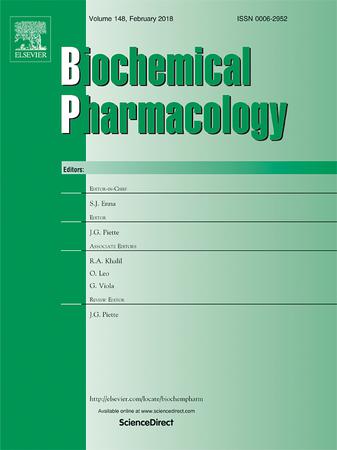Fatty acid synthase inhibition offers protection against pressure-induced cardiac hypertrophy
IF 5.6
2区 医学
Q1 PHARMACOLOGY & PHARMACY
引用次数: 0
Abstract
Disturbed cardiac metabolism is an important aspect of the pathology of Cardiac hypertrophy (CH) which precede Heart failure (HF). Studies have shown a higher rate of De novo lipogenesis in HF and its inhibition has been protective. However, its role in CH still needs further clarification. For in vitro studies, Phenylephrine (PE) was used to induce CH in adult human ventricular cardiomyocytes (AC16). For in vivo studies, 2 kidney 1 clip (2K1C) and Transverse aortic constriction (TAC) models of rat were used. Fatty acid synthase (FAS), key enzyme of lipogenesis was inhibited using FAS si RNA (30 nM) and C75 (2 mg/kg, i.p. once a week for 8 weeks) in vitro and in vivo respectively. Echocardiography and histochemical staining were used to observe cardiac remodeling. Western blotting, Seahorse analysis, fluorescence microscopy and FACS were performed to detect metabolic alterations, mitochondrial dysfunction, protein synthesis and hypertrophy. We observed increased expression and activity of FAS in PE-exposed AC16 and 2K1C and TAC models of rats. Inhibition of FAS decreased hypertrophy, protein synthesis by malonylation of mTOR, apoptosis, glycolysis, and oxidative stress and restored oxidative phosphorylation in AC16 cells. In rats, FAS inhibition prevented cardiac remodelling in 2K1C and TAC models. It also increased ATP, restored mitochondrial ROS and membrane potential in the TAC model of rats. Our results demonstrated that FAS activity was modulated during CH, and inhibiting it prevented cardiac remodelling and mitochondrial dysfunctions. The findings, therefore, suggest that inhibiting FAS may be a new therapeutic approach to treating CH patients.

脂肪酸合酶抑制对压力诱导的心肌肥厚提供保护。
心脏代谢紊乱是心衰(HF)前心肌肥厚(CH)病理的一个重要方面。研究表明HF患者有较高的从头脂肪生成率,对其抑制具有保护作用。然而,它在CH中的作用还需要进一步澄清。在体外研究中,用苯肾上腺素(PE)诱导成人心室心肌细胞(AC16)产生CH。体内实验采用大鼠肾1夹(2K1C)和主动脉横缩(TAC)模型。体外和体内分别用FAS si RNA(30 nM)和C75(2 mg/kg,每周1次,连续8 周)抑制脂肪生成的关键酶脂肪酸合成酶(FAS)。超声心动图及组织化学染色观察心脏重构。Western blotting、海马分析、荧光显微镜和FACS检测代谢改变、线粒体功能障碍、蛋白质合成和肥大。我们观察到在pe暴露的大鼠AC16和2K1C及TAC模型中FAS的表达和活性增加。FAS的抑制降低了AC16细胞的肥大、mTOR丙二醛化蛋白合成、凋亡、糖酵解和氧化应激,并恢复了氧化磷酸化。在大鼠中,FAS抑制阻止了2K1C和TAC模型的心脏重塑。在TAC大鼠模型中,它还能增加ATP,恢复线粒体ROS和膜电位。我们的研究结果表明,FAS活性在CH期间被调节,抑制它可以防止心脏重塑和线粒体功能障碍。因此,研究结果表明,抑制FAS可能是治疗CH患者的一种新的治疗方法。
本文章由计算机程序翻译,如有差异,请以英文原文为准。
求助全文
约1分钟内获得全文
求助全文
来源期刊

Biochemical pharmacology
医学-药学
CiteScore
10.30
自引率
1.70%
发文量
420
审稿时长
17 days
期刊介绍:
Biochemical Pharmacology publishes original research findings, Commentaries and review articles related to the elucidation of cellular and tissue function(s) at the biochemical and molecular levels, the modification of cellular phenotype(s) by genetic, transcriptional/translational or drug/compound-induced modifications, as well as the pharmacodynamics and pharmacokinetics of xenobiotics and drugs, the latter including both small molecules and biologics.
The journal''s target audience includes scientists engaged in the identification and study of the mechanisms of action of xenobiotics, biologics and drugs and in the drug discovery and development process.
All areas of cellular biology and cellular, tissue/organ and whole animal pharmacology fall within the scope of the journal. Drug classes covered include anti-infectives, anti-inflammatory agents, chemotherapeutics, cardiovascular, endocrinological, immunological, metabolic, neurological and psychiatric drugs, as well as research on drug metabolism and kinetics. While medicinal chemistry is a topic of complimentary interest, manuscripts in this area must contain sufficient biological data to characterize pharmacologically the compounds reported. Submissions describing work focused predominately on chemical synthesis and molecular modeling will not be considered for review.
While particular emphasis is placed on reporting the results of molecular and biochemical studies, research involving the use of tissue and animal models of human pathophysiology and toxicology is of interest to the extent that it helps define drug mechanisms of action, safety and efficacy.
 求助内容:
求助内容: 应助结果提醒方式:
应助结果提醒方式:


